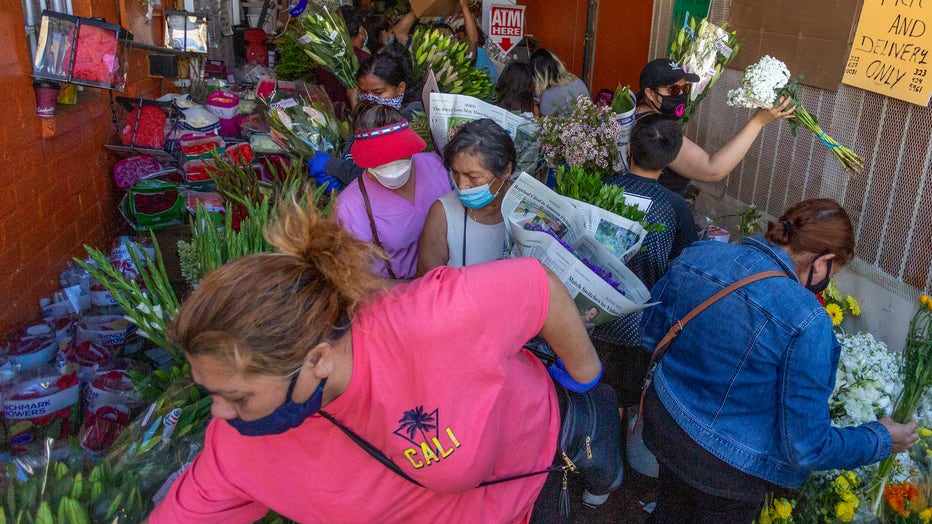Talking produces ‘airborne droplets’ that can linger up to 14 minutes in air, researchers say
LOS ANGELES - A simple and seemingly harmless conversation can produce thousands of oral fluid droplets that can be dispersed to a fairly large radius and can linger in the air for up to 14 minutes, and in some instances even longer, researchers suggest in a new study that may help answer key questions regarding the high transmissibility of the novel coronavirus.
According to the report, that was first published in the peer-reviewed journal “Proceedings of the National Academy of Sciences,” it is commonly known that respiratory viruses such as COVID-19 can spread through droplets that are produced from coughing or sneezing.
What is not as well understood is that normal speech between individuals can produce just as many respiratory droplets that can remain in the air for at least eight minutes and can help respiratory viruses spread just as efficiently.
RELATED: CDC indicates that people can spread novel coronavirus to pets in some situations
Scientists at the National Institute of Diabetes and Digestive and Kidney Diseases and the University of Pennsylvania used laser light to identify exactly how many droplets are emitted during a standard human conversation.

FILE - People mingle close to one another as businesses in the flower district in Skid Row reopen in time for Mother's Day on May 8, 2020 in Los Angeles, California. (Photo by David McNew/Getty Images)
“Highly sensitive laser light scattering observations have revealed that loud speech can emit thousands of oral fluid droplets per second," the authors wrote.
The study did not analyze droplets from people with COVID-19, but was intended to illustrate one of the ways in which the virus can spread.
With social distancing still the best known weapon for containing the the virus, several studies have been conducted regarding the transmission of respiratory droplets. The U.S. Centers for Disease Control and Prevention has warned that COVID-19 is known to spread through these droplets in the air.
The findings from the studies have prompted the CDC to recommended that people keep a minimum of 6 feet apart from someone who may be sick with COVID-19.
One study conducted by researchers at MIT in March warned that droplets of the novel coronavirus could travel as far as 27 feet.
RELATED: Virus-afflicted 2020 looks like 1918 despite science's march
It raised eyebrows in the medical community, including with Dr. Anthony Fauci, the director of the National Institute of Allergy and Infectious Diseases, who urged caution on its findings.
“This could really be terribly misleading,” Fauci said at a March 31 White House press briefing, adding that it would apply only to people with extremely strong sneezes.
In another study conducted by the CDC in April, researchers suggested that the "maximum transmission distance of SARS-CoV-2 aerosol" could be 4 meters or 13 feet.
The study analyzed surface and air samples from an intensive care unit as well as a general COVID-19 ward at a hospital in Wuhan, China.
In testimony Tuesday before a Senate committee on the Trump administration’s coronavirus response, Fauci, who is the nation’s leading infectious disease expert, warned there is still much to learn about the virus, specifically around how it spreads.
And while the CDC has warned that COVID-19 can transmit via droplets in the air, the agency also warns that the coronavirus can survive for days on hard surfaces.
A separate experiment intended to show just how easily the virus can spread through physical surfaces and contact was recently filmed by Japan’s public broadcast organization NHK.
RELATED: Video shows how quickly COVID-19 can spread in buffet-style restaurant setting
The video was intended to illustrate the speed at which a virus like COVID-19 can spread on a setting like a cruise ship or buffet-style restaurant.
The experiment involved 10 participants. One person was designated as “patient 0." Assuming that the infected person suppressed their cough with their hand, a fluorescent paint only visible under ultraviolet light was applied to that person’s palm to illustrate the virus.
The rest of the participants, including the “infected“ individual, were then allowed to enjoy a free buffet provided to them for the next 30 minutes, after which the invisible paint appeared to spread everywhere.
As pre-pandemic social norms become questionable in the pandemic era, studies like the one that analyzes respiratory droplets produced from something as normal as small talk help medical experts to better identify safer practices that may help prevent future infection spikes as states reopen.
“This direct visualization demonstrates how normal speech generates airborne droplets that can remain suspended for tens of minutes or longer and are eminently capable of transmitting disease in confined spaces,” the authors wrote.
The Associated Press contributed to this story.

